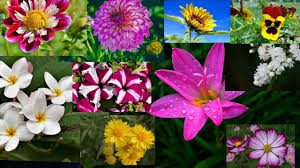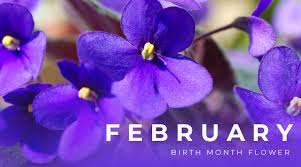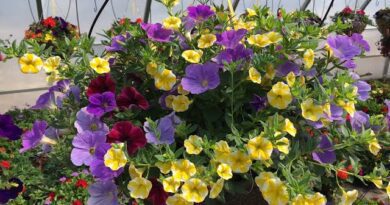All You Need To Know About The Different Types of Flowers
Flowers have captivated the human imagination for centuries with their stunning beauty, vibrant colors, and enchanting fragrances. These wonders of nature come in a plethora of shapes, sizes, and varieties, each possessing its own unique charm. From the elegant roses to the delicate orchids, the world of flowers offers an endless array of visual delights.
In this article, we will delve into the fascinating world of flowers and explore some of the most popular types found across the globe.
1. Roses
Roses are undoubtedly the most iconic and universally recognized flowers. With their velvety petals and sweet scent, they symbolize love, beauty, and passion.
Available in a wide range of colors, including red, pink, yellow, and white, roses are often used in bouquets, gardens, and for various ornamental purposes. From hybrid tea roses to climbing roses, each variety possesses its own distinct characteristics, making roses a perennial favorite.
2. Tulips
Tulips are celebrated for their vibrant hues and graceful shapes. Originating from Persia, these bulbous flowers have become synonymous with the Netherlands, where they are cultivated extensively.
Tulips showcase a rainbow of colors, ranging from bold reds and yellows to softer pastel shades. With their simple yet elegant blooms, tulips are commonly associated with spring and are popular for both indoor and outdoor gardening.
3. Orchids
Orchids are known for their unparalleled elegance and exotic allure. These extraordinary flowers display intricate patterns, vibrant colors, and fascinating shapes. Orchids boast an incredible diversity, with over 28,000 known species.
From the delicate Phalaenopsis to the flamboyant Cattleya, each orchid variety has its own distinct beauty. With their reputation as symbols of luxury and refinement, orchids are highly prized and often featured in floral arrangements and as indoor houseplants.
4. Sunflowers
As the name suggests, sunflowers exude warmth and radiance with their large, golden blooms. These cheerful flowers symbolize happiness, loyalty, and adoration. Sunflowers are native to the Americas and have become popular worldwide.
They are characterized by their tall, sturdy stems and bold, yellow petals surrounding a central disc. Sunflowers not only brighten gardens but also serve as a source of edible seeds and are associated with feelings of joy and positivity.
5. Lilies
Lilies are renowned for their majestic beauty and intoxicating fragrance. These elegant flowers come in a variety of colors, including white, pink, yellow, and orange.
With their trumpet-shaped petals and prominent stamens, lilies are often used in floral arrangements and are a common choice for special occasions such as weddings and funerals. Lilies carry symbolic meanings across different cultures, representing purity, innocence, and rebirth.
However, Flowers have a magical ability to uplift our spirits, inspire creativity, and bring joy to our lives. The world of flowers is a diverse and captivating one, offering an endless assortment of colors, shapes, and fragrances.
Whether it’s the romantic allure of roses, the delicate beauty of orchids, or the vibrant cheerfulness of sunflowers, each type of flower has its own story to tell. So, take a moment to appreciate the beauty that surrounds us and immerse yourself in the enchanting world of flowers.
Read Also: The Different Cocao Tree Varieties
Lotus Flower
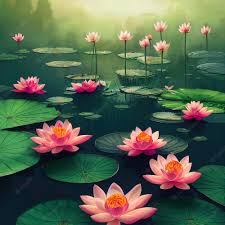
The lotus flower, with its exquisite beauty and profound symbolism, holds a special place in the hearts and minds of people across various cultures and religions.
Revered for its ability to emerge gracefully from murky waters and bloom into a pristine flower, the lotus serves as a powerful metaphor for transformation, purity, and enlightenment.
Here are the symbolism, physical characteristics, and cultural significance of lotus flowers;
Symbolism and Spiritual Significance
The lotus flower is deeply rooted in spiritual and religious traditions. In Hinduism and Buddhism, it symbolizes purity of body, mind, and speech, as it emerges unscathed from the muddy depths to blossom in pristine beauty.
The unfolding petals of the lotus represent the awakening of spiritual enlightenment, and its ability to rise above adversities serves as an inspiration for personal growth and spiritual evolution.
Physical Characteristics
The lotus is an aquatic perennial plant that thrives in shallow, freshwater environments such as ponds and lakes. It is characterized by its distinct circular leaves, long stalks, and stunning flowers. Lotus flowers come in a variety of colors, including white, pink, red, and blue.
The flowers have multiple layers of delicate petals that gradually unfold, revealing their intricate beauty. The unique structure of the lotus flower, with its ability to stay clean and dry despite growing in muddy conditions, further adds to its mystique.
The lotus flower holds immense cultural significance in many parts of the world. In ancient Egypt, the lotus was a symbol of creation and rebirth, associated with the sun god Ra. In Chinese culture, the lotus represents purity, perfection, and harmony.
It is also a cherished symbol in Buddhist and Jain art, where it is often depicted as a seat or throne for divine beings. The lotus is frequently used in traditional Asian medicine, cuisine, and various art forms, reflecting its enduring influence.
The lotus flower’s journey from the murky depths to the surface mirrors the human experience. It represents the triumph of light over darkness, knowledge over ignorance, and beauty emerging from challenging circumstances.
The lotus teaches us the importance of resilience, inner strength, and the ability to bloom despite adverse conditions. Its delicate yet sturdy nature reminds us to embrace our own vulnerabilities while staying grounded and steadfast.
The lotus flower embodies beauty, grace, and spiritual awakening. Its symbolic significance and cultural importance have made it a revered and cherished symbol throughout history.
As we contemplate the lotus flower’s journey from the depths of the water to the height of beauty, we are reminded of our own potential for growth, transformation, and enlightenment. May the lotus inspire us to rise above challenges, embrace our true nature, and find peace and serenity in the midst of life’s complexities.
Wildflower
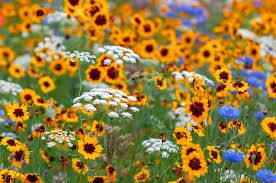
Wildflowers, with their vibrant colors and delicate petals, hold a special place in nature’s tapestry. These unassuming beauties grace meadows, forests, and mountainsides, adding a touch of magic to the landscape. Beyond their visual appeal, wildflowers play a crucial role in supporting biodiversity and providing sustenance for various species.
Now let us delve further into exploring their significance, diversity, and the joys they bring to both humans and the ecosystem.
Wildflowers are not just pleasing to the eye; they also serve vital ecological functions. They attract and support pollinators, such as bees, butterflies, and hummingbirds, which play a crucial role in the reproduction of many plant species.
Additionally, wildflowers contribute to soil health by preventing erosion, enhancing water filtration, and acting as natural indicators of environmental conditions. Their diverse and intricate relationships with other organisms make wildflowers indispensable to the delicate balance of ecosystems.
Wildflowers exhibit an astonishing array of colors, shapes, and sizes. From the fiery orange California poppy to the elegant purple lupine and the delicate white baby’s breath, these floral gems offer a spectrum of hues that paint the landscape with enchantment.
Some wildflowers bloom for only a brief period, while others blossom throughout the year, ensuring a continuous display of natural beauty. The sheer diversity of wildflowers is a testament to the resilience and adaptability of plant life.
Wildflowers have developed remarkable adaptations to survive in various habitats and climates. Some species thrive in harsh desert conditions, while others flourish in damp meadows or high-altitude mountain ranges.
These adaptations include deep root systems for efficient water absorption, specialized leaves to reduce moisture loss, and even symbiotic relationships with fungi for enhanced nutrient uptake. Exploring the unique adaptations of different wildflowers unveils the incredible evolutionary strategies of these resilient plants.
Beyond their ecological significance, wildflowers hold a special place in human hearts. They have been a source of inspiration for artists, poets, and nature enthusiasts throughout history.
Wildflower meadows attract visitors seeking solace in the serenity of nature, and many photographers strive to capture their ephemeral beauty. Furthermore, wildflowers have been used in traditional medicine, culinary practices, and even as natural dyes. Their presence serves as a reminder of the interconnectedness between humans and the natural world.
As habitats face increasing pressures from urbanization, climate change, and habitat loss, the conservation of wildflowers becomes paramount. Organizations and individuals worldwide are working diligently to protect these delicate ecosystems and promote sustainable practices.
By raising awareness, restoring habitats, and encouraging the cultivation of native wildflowers, we can preserve their beauty for future generations and safeguard the vital ecological services they provide.
Wildflowers are not mere adornments of the natural world; they are integral components of thriving ecosystems and sources of wonder and inspiration for humans.
From their ecological significance to their diverse adaptations and aesthetic appeal, wildflowers continue to captivate our imagination. As we immerse ourselves in the enchanting world of wildflowers, let us cherish and protect these fragile treasures that bring joy, biodiversity, and a touch of magic to our lives.
1800 Flower

Flowers have long been cherished for their beauty, fragrance, and ability to convey emotions. In the world of floral gifting, 1800-Flowers has established itself as a renowned name, delivering fresh and stunning blooms to celebrate life’s special moments.
With an extensive collection of flowers, plants, and gifts, 1800-Flowers offers a seamless and delightful experience for individuals seeking to express their sentiments, commemorate milestones, or simply bring a smile to someone’s face.
Now let us delve further into exploring the essence of 1800-Flowers and how they help create meaningful connections through the language of flowers.
One of the highlights of 1800-Flowers is its vast selection of flowers. Whether you’re looking for classic roses, vibrant sunflowers, elegant lilies, or exotic orchids, the website offers a diverse range of options to suit every taste and occasion.
With seasonal arrangements and bouquets crafted by skilled floral designers, 1800-Flowers ensures that each order is filled with the freshest blooms, carefully hand-picked to convey your heartfelt sentiments.
Recognizing that every occasion is unique, 1800-Flowers offers a variety of arrangements tailored to specific celebrations. From birthdays and anniversaries to graduations and new baby arrivals, their team of expert florists creates stunning arrangements that capture the spirit of the occasion.
Additionally, the website allows customers to customize their bouquets with add-ons like balloons, chocolates, and stuffed animals, adding an extra touch of personalization to their gift.
1800-Flowers understands the importance of timely delivery, ensuring that your chosen blooms arrive fresh and vibrant. With a network of local florists and a strong logistics system, they offer same-day and next-day delivery options across many locations, allowing you to surprise your loved ones even when time is of the essence. The website also provides real-time order tracking, keeping you informed every step of the way.
In addition to their impressive floral selection, 1800-Flowers offers a wide array of gift options to complement your chosen blooms. From gourmet gift baskets filled with delectable treats to luxurious spa sets, wines, and personalized keepsakes, you can find the perfect accompaniment to express your sentiments. These thoughtful additions enhance the overall gifting experience and make 1800-Flowers a one-stop destination for all your celebratory needs.
At 1800-Flowers, customer satisfaction is paramount. The company takes pride in providing exceptional service and ensuring that every customer’s experience is smooth and enjoyable. Their knowledgeable customer service representatives are available 24/7 to assist with any inquiries or concerns, ensuring that your interactions with 1800-Flowers are met with warmth, professionalism, and a commitment to excellence.
1800-Flowers has earned its reputation as a trusted and reliable floral provider, offering an extensive range of fresh blooms, personalized arrangements, and thoughtful gifts to commemorate life’s special moments.
With their commitment to quality, convenience, and exceptional customer service, they continue to be a go-to destination for individuals seeking to express their emotions and create meaningful connections through the language of flowers.
Read Also: Propagation Of Cocoa Trees: Nursery Operations
Blue Flower

In the world of flowers, blue is a color that captivates the imagination and evokes a sense of tranquility and serenity. While blue is relatively rare in the plant kingdom, there are a handful of stunning blue flowers that add a unique touch to gardens, bouquets, and floral arrangements.
Now let us delve further into the enchanting world of blue flowers, exploring their symbolism, popular varieties, and the mesmerizing beauty they bring to our lives.
Blue flowers are often associated with calmness, tranquility, and spirituality. The color blue has a soothing effect on the mind and is said to promote feelings of relaxation and peace.
Blue flowers are also seen as symbols of loyalty, trust, and devotion, making them popular choices for expressing heartfelt emotions in various contexts, such as romantic relationships or acts of friendship.
Forget-Me-Not: With their delicate, sky-blue petals, forget-me-nots are often associated with remembrance and enduring love. These dainty flowers add a touch of whimsy to gardens and are cherished for their charming appearance.
Cornflower: Also known as bachelor’s button, the cornflower displays vibrant, deep blue blossoms. Traditionally, they symbolize delicacy and purity. These hardy flowers are beloved by pollinators and make striking additions to both wildflower meadows and cultivated gardens.
Hydrangea: While hydrangeas come in various colors, certain varieties produce beautiful blue blooms. These large, showy flowers evoke a sense of grace and abundance. Hydrangeas are popular in floral arrangements and add a touch of elegance to any setting.
Morning Glory: Known for their stunning trumpet-shaped blossoms, morning glories come in various shades of blue. These vines are cherished for their ability to climb and create enchanting displays along fences, trellises, or arbors.
Blue Iris: The blue iris is a symbol of wisdom, faith, and hope. These striking flowers feature intricate petals in different shades of blue, often with accents of yellow or white. Blue irises are prized for their unique form and are often used in bouquets and floral designs.
Blue Delphinium: Tall and majestic, delphiniums produce stunning spikes of blue flowers. These blooms convey a sense of grandeur and dignity, making them popular choices for formal arrangements or garden focal points.
Blue Orchid: Orchids are known for their exotic beauty, and the blue orchid stands out as a rare and captivating variety. Blue orchids symbolize rarity, elegance, and spirituality, making them coveted and cherished by flower enthusiasts.
Blue flowers, with their serene and captivating presence, bring a sense of calm and beauty to any setting. Whether they symbolize love, loyalty, purity, or spirituality, blue blooms hold a special place in our hearts.
By incorporating these enchanting flowers into gardens, bouquets, or floral arrangements, we can appreciate the tranquil allure they offer and embrace the soothing impact of nature’s vibrant hues.
Read Also: The Neal Recycling Initiative

